|
Faults formed by shearing of bedding planes are common due to the fact that bedding planes are pervasive in sedimentary rocks and they are almost always weaker against shear with respect to the adjacent rock matrix. Figures 1, 2, and 3 are three examples of the bed-parallel slip in aeolian sandstones. Figure 1 shows a series of small faults formed by shearing of cross beds. These in Figure 2 and Figure 3 occurred by shearing of dune boundaries in larger scale as indicated by truncating arrays of fractures at an angle to the boundaries.
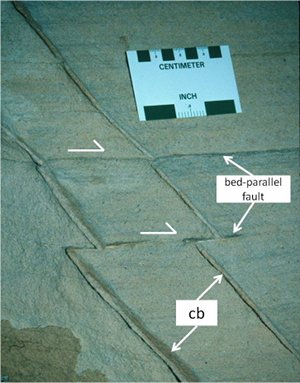 | | Figure 1. Low-angle bedding-plane faults offsetting two older high-angle compaction bands (cb) (top to right sense as indicated by arrows) in sandstone exposed at Valley of Fire State Park, Nevada. |
 | | Figure 2. Normal sense of shearing across a dune boundary marked by a thin fine-grained unit, which produced a dense population of splay joints immediately above the sheared dune boundary at this site. View to the northeast, northwest of the Mouse's Tank rest stop at Valley of Fire State Park, Nevada. |
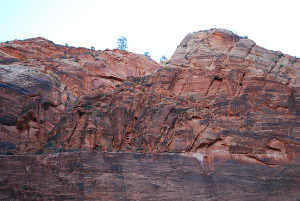 | | Figure 3. An array of fractures truncating against a bedding plane in Navajo Sandstone exposed on the eastern slope of the Virgin River gorge at Zion National Park, Utah. Note the tree on the top side for scale. |
Figure 4 shows a multilayer sequence and a series of fractures and faults in the middle of the unit. The spatial association among these fractures and thin shale layers suggests that shearing across the shale layers is responsible for the inclined fractures, some of which also sheared.
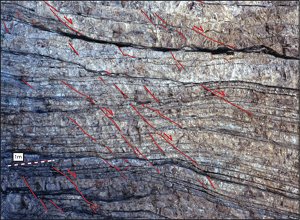 | | Figure 4. Low-angle to bedding fractures, some of which are sheared in a normal sense primarily within the middle unit. The spatial association of these fractures and faults with very thin shale layers suggests that the low-angle fractures are splay fractures associated with bed-parallel shearing across shale layers. Notice that the middle section in which extension due to normal faulting is concentrated, is thinner than the same unit to the right and left. Bolivian fold and thrust belt. |
Figure 5 shows bed-parallel faults in folded carbonaceous shale which are commonly referred to as flexural slip faults. Because beds undergo considerable tilting and rotation during the history of folding and any other complex deformation, weak interfaces result in bed-parallel slip which has significant consequences in terms of fracture and fault localization and their orientation.
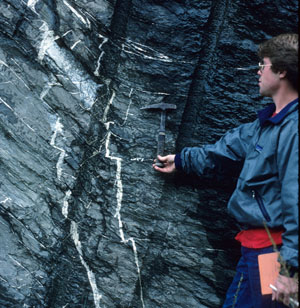 | | Figure 5. Bed-parallel slip along low-angle beds in carbonaceous shale cropping out on a road cut in Bays Mt., northeastern Tennessee. Notice top to right sense of slip (thrust) across two high-angle calcite veins. |
The behavior of interfaces and the properties of adjacent beds are also important and may vary during the diagenetic history. For example, the chert layers within thinly bedded marl and limestone in Figure 6 and Figure 7 appear to be very effective in localizing bed-parallel shear. Notice that the splay pressure solution seams in both figures are related to bed-parallel slip. The pressure solution seams in Figure 6 have been sheared in a normal sense which is counterintuitive given the sense of bed-parallel shearing.
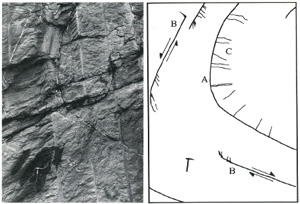 | | Figure 6. Photograph and map showing bed-parallel slip and the associated splay veins in the hinge of an overturned syncline exposed on a road cut at Bays Mountain, northeastern Tennessee. Locations marked by 'B' show bed-parallel faults as well as splay veins, indicating a symmetric sense of slip across the faults compatible with a flexural slip mechanism. From Ohlmacher and Aydin (1995). |
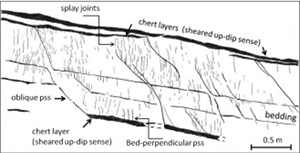 | | Figure 7. Bedding-parallel faults in marl in the Majella thrust sheet, central Apennines, Italy. Thin chert layers and other bed interfaces localize shearing and produce splay pressure solution seams (thicker lines at an acute angle to bed) which have in turn sheared judging from the associated splay joints (thinner lines at acute angles to the splay seams). There are also background pressure solution seams both parallel and perpendicular to bedding which were not differentiated here. From Antonellini et al. (2008). |
Another important consequence of bed-parallel shearing is the formation of breccia zones with high porosity and permeability within the layers whose boundaries were sheared. A good example of this can be seen in the Monterey Formation, a well-known reservoir rock in California, and is described under 'Case Studies.'
The cross sections in two different scales, in Figure 8 and Figure 9, illustrate more complex situations in which thinly bedded silica clastic rocks in central Thailand and coastal California were tightly folded with generally sharp hinge sections. They also include many thrust and normal faults that are nearly either bed-parallel or fold-axis-parallel except when they cut across hinge areas or overturned limbs.
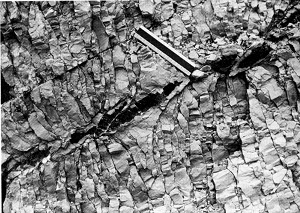 | | Figure 8. The imbrication of a chert layer diagonal to the picture frame by bed-parallel shearing and shortening in the Scaglia Rossa limestone in Umbrian Apennines. Within the layers shortening was accommodated primarily by pressure solution seams, the curvature of which is due to the geometry of the stress trajectories around the tips of bed-parallel fault segments. From Alvarez et al. 1976. |
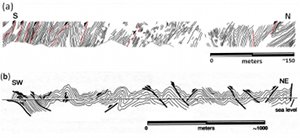 | | Figure 9. (a) Folding and faulting of thinly bedded silica clastic rocks of the Sap Bon Formation in central Thailand. Note that the thrust fault traces are sub-parallel to bedding and in some cases fold axes. From Wongseekaew et al. (unpublished). (b) Tightly folded thin beds of siliceous rocks with thrust faults formed sub-parallel to bedding and fold axes in the limb sections of the folds, Arroyo Burro Beach, Santa Barbara, California. From Gross et al. (1998). |
| |
Alvarez, W. , Engelder, T., Lowrie, W., 1976. Formation of spaced cleavage and folds in brittle limestone by dissolution. Geology 4 (11): 698-701.
Antonellini, M., Tondi, E., Agosta, F., Aydin, A., Cello, G., 2008. Failure modes in deep-water carbonates and their impact for fault development: Majella Mountain, Central Apennines, Italy. Marine and Petroleum Geology 25: 10, 1074-1096, doi:10.1016/j.marpetgeo.2007.10.008.
Gross, M.R., Gutierrez-Alonso, G., Bartlett, W.L., 1998. Fold-related fractures in coastal outcrops of the Monterey Formation: Effect of structural style, Mechanical stratigraphy, and scale at Arroyo Burro Beach. In Eichhuble, P., and Behl, R. J. (1998). Diagenesis, deformation, and fluid flow in the Miocene Monterey Formation. The Pacific Section of Economic Paleontologists and Mineralogists, Special Publication 83.
Ohlmacher, G., Aydin, A., 1995. Progressive deformation and fracture patterns during foreland thrusting in the Southern Appalachians. American Journal of Science 295 (8): 943-987.
Wongseekaew, K., Aydin, A., Kanjanapayont, P., 2013. Structural characterization of a siliceous sedimentary rock of Sap Bon Formation in Loei - Phetchabun fold and thrust belt, Thailand, and a comparison with porcelanite of Monterey Formation, California USA. (unpublished).
|








